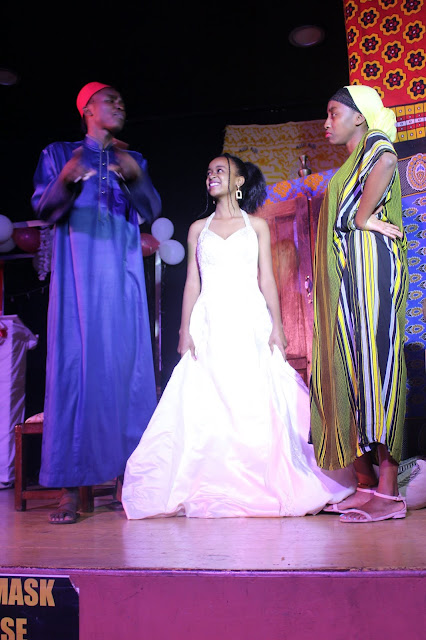GREENMAN COMBINES TRADITION AND MYTH WITH CONTEMPORARY ART
By
Margaretta wa Gacheru (posted August 24, 2021)
Greenman is
known among friends and fellow artists by that name only. Few people even
question his ‘true identity’ since it’s the only name he answers to.
Yet Muleh
Mbillo had a busy life before he found himself in a trance (or coma) and met
the original Green Man years ago. In a chat with Weekender, he explains
how this green man engaged him for several days, sharing so much wisdom that
Muleh felt he wanted to be like him, wise, generous, and all-knowing.
Meeting a
holy man in a dream didn’t feel out of the ordinary to Muleh. His family had
introduced him to traditional seers or ‘mundu muue’ as they are called in
Kikamba at an early age. “They also took me to see modern medical doctors, so I
would know both traditional and modern practices. Then I could choose for
myself,” he says. ”That’s why my meeting a [literally] wise green man in a
dream didn’t feel peculiar to me,” he adds.
During DN LifeandStyle’s rendezvous with Greenman at Nairobi National Museum where he’s part of a group
exhibition entitled ‘Disobedient Devices’, he explains more about his name. “I didn’t just want to be like the
green man. I wanted to be him, and that is how I acquired the name.”
Greenman
shares the show with Joan Otieno of Warembo Wasanii, Moira Bushkimani of Brush
tu Artists Collective and Dani Ploeger, a Dutch post-doctoral researcher from
University of London. All four created art forms reminiscent of devices used
traditionally in ritual practices. In addition, Joan, Dani, and Greenman
created three short films to dramatize the way those devices were used
historically. For instance, in ‘Reconstructive Prophesy’ Greenman takes on the
role of a ‘mundu muue’ who uses his magical machine as a medium to receive
divine counsel and then share it with his clients. In Joan Otieno’s ‘Medusa’s
Coil’, it’s a snake that embodies powers her community traditionally revered.
And in Ploeger’s The Cults’, the Dutch researcher dramatizes his interest in
examining what he calls ‘the intersection between visual art and cultural
studies in technology.’
The
multimedia exhibition grew out of a connection Greenman made with Ploeger in
2016. “We’ve done several projects with Dani since then. Our current exhibition
began with two workshops that took place in 2019,” Greenman recalls. “Those
were attended by Joan and Bushkimani as well as several others.”
The
challenge that the Dutchman posed to the Kenyans during the second workshop was
to consider their cultural myths and traditional rituals as well as the
technologies traditionally used to carry out those practices. Then let their
imaginations go.
The fruits
of that challenge are essentially what constitute the ‘Disobedient Devices’
exhibition. The three videos which were each scripted as science fiction by
Greenman, Otieno, and Ploeger are being shown and repeated in a looped fashion,
so one can watch all three in a matter of minutes once you reach the Creativity
Gallery at the Museum.
The traditional
technologies on display have been re-imagined and constructed’ using waste materials
collected by the four exhibiting artists from the Dandora dumpsite where Joan
normally scavenges all the ‘found objects’ used in her Warembo Wasanii studio
in Ngomongo.
Greenman
confirms that he made his traditional Akamba ‘technology’ from an old radio set
that he found at the dump and then repainted using symbols he recalled from his
first meeting with a mundu muue when he was a child.
“I was four
years old when I went with my family to meet the mundu muue who performed a
series of rituals and incantations for us. He also used his Nzevu (single
stringed instrument) to create what I think was meant to be a spiritual bond
between our family,” he says
That early
encounter with a traditional seer never left Greenman, despite his studying
mechanical engineering at Kenya Polytechnic. Instead, it led to his study of
both traditional and mainstream religions and philosophies. Ultimately, that
led him to translate his studies into the arts.
“I realized
art was another way of tuning into Infinity,” he says. Art is also how he
recreated the mundu muue’s mystical ‘radio set’ which is on display at
the Exhibition.
Currently,
Greenman is working with the Maasai Mbili Artists Collective.





































